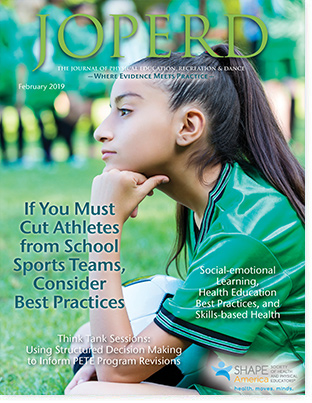 JOPERD Table of Contents
JOPERD Table of Contents
If You Must Cut Athletes from School Sports Teams, Consider Best Practices
Douglas L. Gleddie, Lauren D. Sulz, Louise M. Humbert, and Adam P. Zajdel

Youth who meet the recommended 60 minutes per day of physical activity are healthier (Lemstra, Nielsen, Rogers, Thompson, & Morris, 2012). In addition, sport participation in schools can contribute to academic success (Bowen & Hitt, 2016). However, many youth discontinue or “quit” sport during adolescence (Canadian Fitness and Lifestyle Research Institute [CFLRI], 2016), sometimes as a result of being cut from a sports team (Fraser, Thomas, Côté, & Deakin, 2008). Cutting, or deselecting, does not only affect the athlete. Coaches are also quick to reveal a high level of discomfort with the troublesome nature of this practice (Capstick & Trudel, 2010). Despite the inherent issues with cutting, coaches and athletic directors are often forced to do so for a variety of reasons. These reasons include selecting the best players to be competitive, reducing team sizes due to a limited number of coaches and lack of facility availability, and limited funding. As much as the authors would like to advocate for alternatives to cutting or little to no cutting in school sports (and developmental sport), the reality is that many programs use this practice — so the goal of this article is to address it head on. That being said, a short section at the end of the article provides some alternatives to cutting practices that have been observed in school sports.
There is a general lack of understanding surrounding the practice of cutting athletes. Little in the way of research evidence exists to assist coaches with this difficult task. Even more limited is any clear collection or analysis of school policies that outline best practices for cutting. Most of the literature regarding cutting either neglects the perspectives of athletes and parents (Seifried & Casey, 2012) or is focused on high-performance athletes (Neely, Dunn, McHugh, & Holt, 2016). Therefore, since the authors wanted to find out more about cutting practices and policies in school sports, their study was designed specifically to gain an understanding of: (1) the current practices for cutting youth from school sports teams; (2) the experiences of all those involved in the cutting process; (3) the influence of cutting on youths’ physical, emotional and social state; and (4) best practices for cutting youth from school sports teams. The data were collected across two western provinces in Canada and included an online survey (respondents n = 1,667) that included teacher-coaches (n = 1,280) and school athletic directors (teachers; n = 387) in all regions of both provinces, as well as interviews with students who had been cut (n = 14), their parents (n = 10), coaches (n = 18), school administrators (n = 5), and athletic directors (n = 5; total n = 52). Descriptive statistics were used to summarize the quantitative data set from the online questionnaire. Thematic analysis was undertaken to identify core meanings and themes within the qualitative data (Braun & Clarke, 2006), beginning with searching across the data set to find repeated patterns of meaning. Words and phrases that represented patterns in the data were recorded into initial codes, then sorted into descriptive categories, reviewed, and refined looking for patterns that cohered together meaningfully with clear and identifiable distinctions. Lastly, categories were defined to conceptualize as themes.
To read the rest of this article, click here to download a pdf.